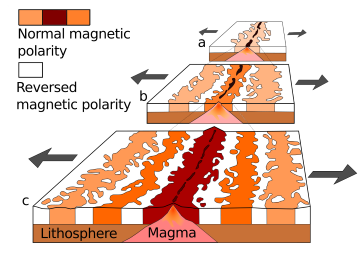7_Crust_edit.png

Scientists use the magnetism of oceanic crust to date it; many of these ridges have been slowing down their spread for the last 15 million years. Credit: Chmee2.
Lots of people would like to experience what appears to be happening on the ocean floor: a slowdown in the rate of spreading out. A recent study suggests that rifts at the bottom of the oceans are spreading more slowly than they were as recently as 15 million years ago.
The rifts mark places where the plates of rock that make up Earth’s crust are spreading apart. As they spread, one end of a plate dives beneath another plate and is recycled into the layer below, the mantle. Hot rock pushes up into the void created by the spreading, forming new crust in the form of underwater mountain ranges.
Researchers looked at the ages of rocks along 18 ridges in all the world’s oceans. They paid special attention to ridges in the eastern Pacific, which are some of the fastest spreading. Their ages are preserved in the magnetic fields of the rocks, so reading the fields is a bit like measuring the age of a tree by counting its rings.
Fifteen million years ago, the average rate of spreading was about eight inches a year; today, it’s about five and a half. The rate is different for different ridges, and not all have slowed down.
Some of the change in that rate could be caused by changes in the plates, such as the build-up of the Andes Mountains in South America. That increases friction, causing the plates to become “stickier.” The slow-down also could be caused by big changes in motions in the mantle or other effects—slowing down the spreading of the ocean floor.

